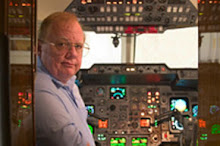'Twas the night before Christmas, and out on the ramp, Not an airplane was stirring, not even a Champ.
The aircraft were fastened to tiedowns with care In hopes that come morning, they all would be there.
The fuel trucks were nestled, all snug in their spots, While peak gusts from three two zero reached 39 knots.
I sank behind the fuel desk, now finally caught up, And settled down comfortably, resting my butt.
When over the radio there arose such a clatter, I turned up the scanner to see what was the matter.
A voice clearly heard over static and snow, Asked for clearance to land at the airport below.
He barked out his transmission so lively and quick, I could have sworn that the call sign he used was "St. Nick".
Away to the window I flew like a flash, Sure that it was only Horizon's late Dash.
Then he called his position, and there could be no denial, "This is St. Nicholas One and I'm turning on final."
When what to my wondering eyes should appear, A Rutan sleigh, with eight Rotax Reindeer.
Cleared for the ILS, down the glideslope he came, As he passed all fixes, he called them by name:
"Now Ringo! Now Tolga! Now Trini and Bacun! On Comet! On Cupid!" What pills was he takin'?
Those last couple of fixes left the controllers confused, They called down to the office to give me the news.
The message they left was both urgent and dour: "When Santa lands, have him please call the tower?"
He landed like silk, with the sled runners sparking, Then I heard "Exit at Charlie," and "Taxi to parking."
He slowed to a taxi and exited Three-Two, As he came down the taxiway the sleighbells' jingle grew.
He stepped out of the sleigh, but before he could talk, I had run out to him with my best set of chocks.
He was dressed all in fur, which was covered with frost And his beard was all blackened from Rotax Reindeer exhaust.
His breath smelled like peppermint, gone slightly stale, And he puffed on a pipe, but he didn't inhale.
His cheeks were all rosy and jiggled like jelly, His boots were as black as a cropduster's belly.
He was chubby and plump, a right jolly old fool, And he kindly informed me that he needed some fuel.
A wink of his eye and a twist of his toes, Let me know he was desperate to powder his nose.
I spoke not a word, but went straight to my work, And I filled up the sleigh, but I spilled like a jerk.
He came out of the restroom with a sigh of relief, And then picked up a phone for a Flight Service brief.
And I thought as he silently scribed in his log, That with Rudolph, he could land in an eighth-mile fog.
Next, he completed his pre-flight, from the front to the rear, Then he put on his headset, and I heard him yell, "Clear!"
And laying a finger on his push-to-talk, He called up the tower for his clearance and squawk.
"After departure fly heading three two zero," the tower called forth,
"And watch for a Luscombe inbound from the North."
Then I heard him proclaim, as he climbed thru the night, "Merry Christmas to all! I have traffic in sight."
To listen to this poem, simply go to:
Twas the night before Christmas
If you are looking for a great deal on Pilot Supplies, then visit my store
at Aviation Sources
Merry Christmas!
John
JetAviator7


